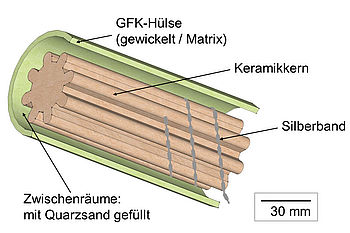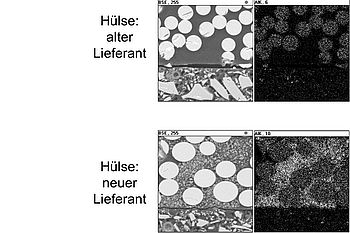Investigation of GRP safety sleeves
Problem: Failure of high-voltage safety sleeves

When high-voltage safety systems leave the production plant, they are regularly checked as part of quality assurance. This involves testing them in electrical switch-off tests, in which temperatures of around 150 °C are reached.
After changing the sleeve supplier, the manufacturer reported a high failure rate in the form of self-ignition. The cause of the damage had to be clarified by comparing new sleeves from both suppliers.
Analysis methods: Combination of morphological, spectroscopic and thermal processes
- Morphological analysis of the glass fibre-reinforced sleeves of the new and old suppliers revealed differences with regard to roughness, pore content and elementary distribution. One striking aspect, for example, was the presence of aluminium in the plastic matrix (resin) of the new sleeves.
- Measuring the degradation behaviour of the new GRP sleeves by thermogravimetric analysis (TGA) revealed the release of substances (presumably water) at comparatively low temperatures (below 200 °C).
- With the aid of material analysis by infrared spectroscopy, different resin systems were detected. The sleeves of the new supplier also contain the flame- retardant aluminium trihydroxide.
Result: Unsuitable flame retardant is the cause of the damage
Apart from the fact that the resin system is different and processing faults were observed, the flame-retardant (ATH) proved to be unsuitable and was established as the cause of the damage.
The elevated temperatures encountered during application lead to degradation of the ATH, resulting in water formation. The condensation can encourage a renewed current flow and can thus damage the mode of functioning.
Any questions?

Christoph Zekorn
Microscopic analysis Head of the Microscopic Analysis Laboratory +49 241 80-28341 christoph.zekorn@ikv.rwth-aachen.deDo you have any questions on the subject of microscopy? Then phone us or send a message.

